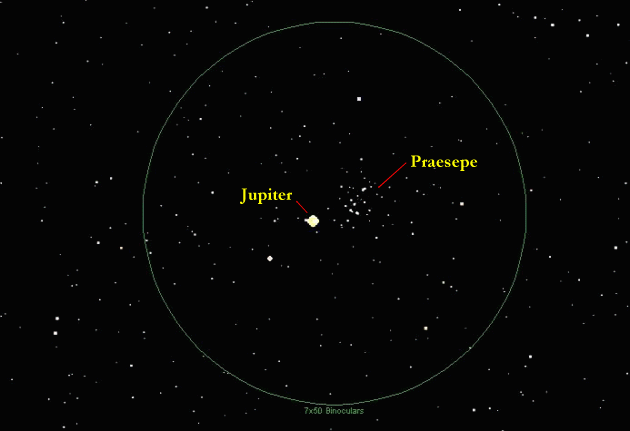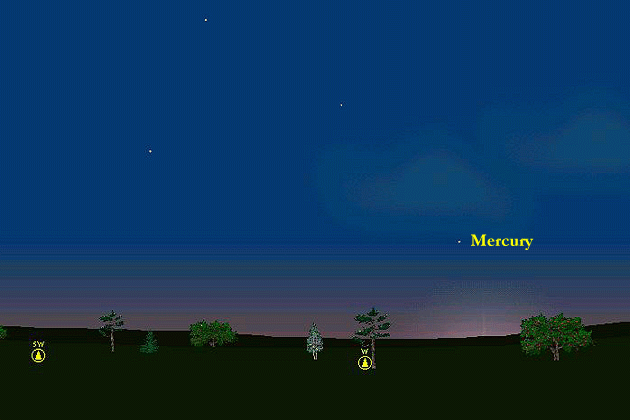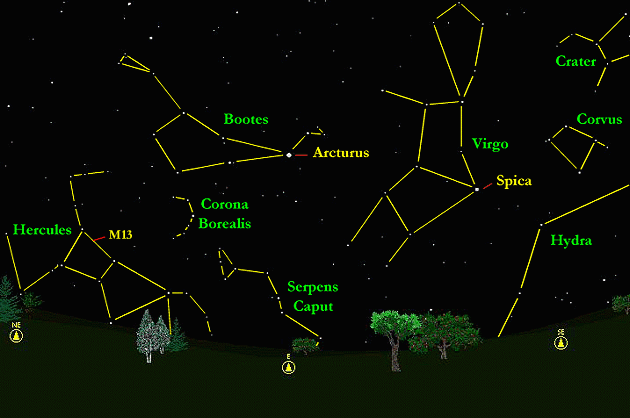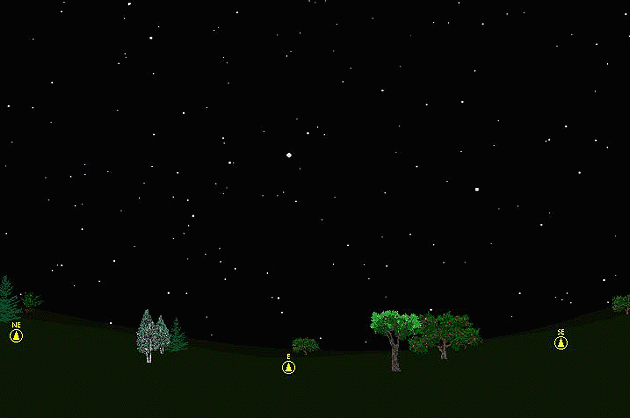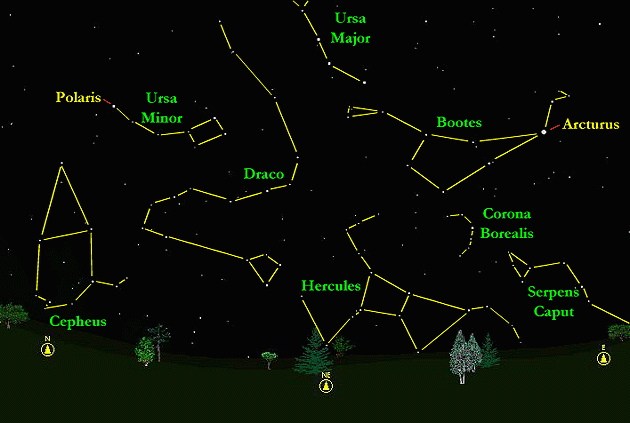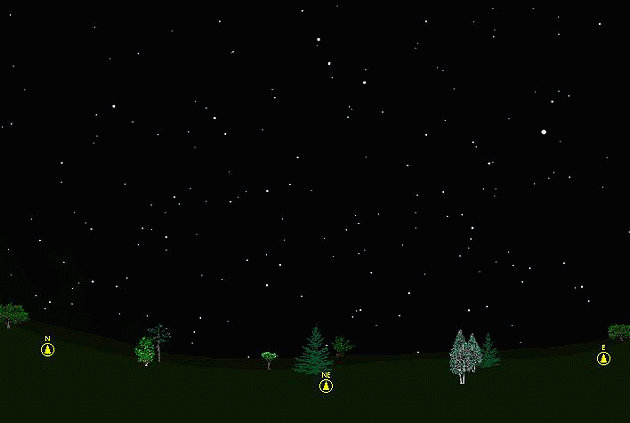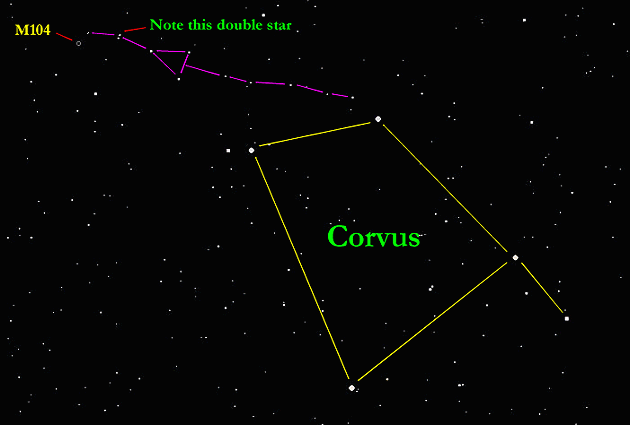The purpose of this feature is to give scout leaders, educators and naturalists an idea of some of the natural events coming up each month. We will try to cover a variety of natural events ranging from sky events to calling periods of amphibians, bird and mammal watching tips, prominent wildflowers and anything else that comes to mind. We will also note prominent constellations appearing over the eastern horizon at mid-evening each month for our area for those who would like to learn the constellations. If you have suggestions for other types of natural information you would like to see added to this calendar, let us know! Note: You can click on the hyperlinks to learn more about some of the featured items. To return to the Calendar, hit the "back" button on your browser, NOT the "back" button on the web page. Sky Events: The Lyrid Meteor Shower: This year's Lyrid meteor shower peaks on the afternoon of April 22nd. A waning gibbous moon rises during the morning hours of April 23rd, so the best time for viewing is between 10:00pm and 2:00am CDT. Look northeast near the bright star Vega, in the constellation Lyra. Vega rises about 9:15 CDT on the 22nd. Evening Sky: Jupiter and Saturn continue to dominate the evening sky. Jupiter is now the brightest object in the evening sky other than the moon. Early in the month, be sure and look at Jupiter in binoculars as it passes Praesepe, the "Beehive" cluster, in the constellation Cancer, the Crab. It's a beautiful view. Jupiter is now about 465,000,000 miles (40 light minutes) away, and is very much in the foreground of the distant star cluster, which is about 525 light years away. You may be able to pick out some of Jupiter's bright moons through binoculars. A binocular view on April 7th is shown below.
Also on April 7th, Saturn's rings reach their maximum tilt toward us, 27 degrees and 1 minute, and the planet is a wonderful sight in a small telescope. Mercury is visible most of the month in the western sky after sunset, reaching it's greatest elongation from the sun on April 16th. Look for it about 30 minutes after sunset. The view at 7:45 pm CDT on April 16th is shown below.
Morning Sky: The planet Venus continues to be dazzling in the morning sky, but by month's end Venus will be hard to spot as it sinks into the morning twilight. Mars rises about a little after 2:00am CDT at mid-month. All times noted in the Sky Events are for Franklin, Tennessee and are Central Daylight Time. These times should be pretty close anywhere in the mid-state area. Constellations: The views below show the sky looking east at 9:00pm CDT on April 20th. The first view shows the sky with the constellation outlined and names depicted. Star and planet names are in yellow. Constellation names are in green. The second view shows the same scene without labels. New constellations this month in the eastern sky are Serpens Caput, the Serpent (Head), and Hercules, the Strongman. With binoculars, look for the globular cluster Messier 13 (M13), which appears like a small fuzzy patch of light about 1/3 of the distance between Eta and Zeta Hercules (see illustration below). A cluster of stars about 21,000 light years away, it can be made out with the naked eye in a dark country sky when the constellation is high in the sky. Locate the constellation Corvus, the Crow, if you wish to find the galaxy M104 as described below.
The illustration below shows the view looking northwest at 9:00pm on April 20th. All of Draco, the Dragon, and Cepheus, King Cepheus, are above the horizon now.
The Peterson Field Guide Galaxy:
Last month we talked about some of the galaxies you may be able to spot with a small telescope in the Virgo Cluster of galaxies. This month we'll concentrate on one galaxy in the Virgo cluster that is also fairly easy to find. A few years ago Walter Scott Houston, who wrote a column for Sky & Telescope magazine, pointed out that M104, the "Sombrero Galaxy," has a celestial "arrow" of faint stars that point to it. The arrow is just above the prominent constellation Corvus, and the stars that make up the arrow are easy to see in binoculars or a telescope finder scope. I can just make out M104 in my 8x30 Zeiss binoculars with averted vision. As with most galaxies you spot with a small telescope, count yourself fortunate if you can see M104 as a small patch of light slightly lighter than the sky background. Remember, this star system is about 65,000,000 light years away! Larger telescopes will show some of the structure shown in the photograph.
The double star shown in the illustration above appears triple at higher magnifications. It's a good check to make sure you're in the right place. Some Viewing Tips for Deep Sky Objects: 1. We can't emphasize enough the importance of a dark sky. If you live in the suburbs, you can sometimes effectively double the size of your telescope by taking it 30 miles or so away from a large city. Pick a night when the moon is not in the sky. If possible, wait till the object is high in the sky. 2. Be sure to rough-align your finder scope during the daytime, then, before you start the exercise, fine-align it on a bright object like Jupiter. It's very frustrating if you're not sure where you are pointing. 3. Coping with Dew: Many manufacturers of small telescopes seem to pretend that there is no such thing as dew. Owners get a rude shock when after 30 minutes outside on their first clear spring night, everything starts to get fuzzy and dim. A look with the flashlight confirms that dew has covered the front lens of the scope. Its not as much a problem in reflecting telescopes or refractors with dew caps, but lens/mirror scopes can dew over very quickly. There are several solutions. The easiest is to make a dew cap out of rolled-up cardboard and let it project out as far as you can from the front of the telescope tube without cutting off some of your field of view. This will slow the formation of dew. Second, you can use a hair dryer (easy does it) to warm the lens slightly before you observe, or use the hair dryer to clear the dew once it has formed. Under a country sky and away from 110V power sources, you can use a battery operated hair dryer (plugs into your "cigarette lighter" ) or your car heater to warm the lens. If these methods do not work sufficiently, you may have to buy one of the commercial dew-prevention systems. If an eyepiece fogs, the best remedy is to carefully remove it and use the car heater to gently warm it until the dew evaporates. 4. Make sure your eyes are dark-adapted. You need to be in darkness for about 45 minutes before observing. 5. If you're having trouble seeing an object, try looking to one side of it so the image falls on the light-sensitive "rods" in your eye. Be patient - it sometimes takes a while for an object to become distinct from the background. This technique is called "averted vision". Don't try too hard or you may start seeing things with "averted imagination." 6. Another trick for seeing faint objects is to lightly tap the tube of the telescope. The motion sometimes makes faint objects noticeable. 7. Cup your hands around the eyepiece to block stray light when trying to see faint objects. I sometimes even drape a black cloth over my head (don't seal it tight, your breath will fog the eyepiece) to see very faint objects. 8. Finally, you can sometimes see more detail in a deep sky object by increasing the power. The eye can see faint objects more easily if they are spread out over a larger area of the retina. On Learning the Constellations: We advise learning a few constellations each month, and then following them through the seasons. Once you associate a particular constellation coming over the eastern horizon at a certain time of year, you may start thinking about it like an old friend, looking forward to its arrival each season. The stars in the evening scene above, for instance, will always be in the same place relative to the horizon at the same time and date each April. Of course, the planets do move slowly through the constellations, but with practice you will learn to identify them from their appearance. In particular, learn the brightest stars (Like Arcturus and Spica in the above scene looking east), for they will guide you to the fainter stars. Once you can locate the more prominent constellations, you can "branch out" to other constellations around them. It may take you a little while to get a sense of scale, to translate what you see on the computer screen or what you see on the page of a book to what you see in the sky. Look for patterns, like the stars that make up the constellation Corvus. The earth's rotation causes the constellations to appear to move across the sky just as the sun and the moon appear to do. If you go outside earlier than the time shown on the charts, the constellations will be lower to the eastern horizon. If you observe later, they will have climbed higher. As each season progresses, the earth's motion around the sun causes the constellations to appear a little farther towards the west each night for any given time of night. If you want to see where the constellations in the above figures will be on May 15th at 9:00pm CST, you can stay up till 11:00pm CST on the April 15th and get a preview. The westward motion of the constellations is equivalent to two hours per month. A good book to learn the constellations is H. A. Rey's classic, The Stars, A New Way to See Them. Rey's depictions of the constellations and witty commentary are terrific. A good general reference book on astronomy is the Peterson Field Guide, A Field Guide to the Stars and Planets, by Pasachoff. The book retails for around $14.00. A good beginners software program for learning the night sky is the Starry Night Beginner program. Visit the Starry Night web site at www.starrynight.com The program retails for around $30.00 and contains a wealth of information.
Amphibians: Many frogs and toads are already calling (see the March 2003 Natural Calendar). We usually hear our first Bullfrogs, Green Frogs, Northern Cricket Frogs, Southern Cricket Frogs, Pickerel Frogs and Fowler's Toads in April, although many of these species can be seen before then. We hear Cope's Gray Treefrog sporadically in March and April on warm days. These early calls of Gray Treefrogs sound raspier than the normal trill, as if the frog needed to clear it's throat. Many of the frogs and toads that began calling earlier in the year, like Spring Peepers, American Toads and Upland Chorus Frogs, continue to call.
Birds: The spring migration builds very quickly in April. The neo-tropical migrants are too numerous to list here, but now is the time to get out in the early morning with a pair of binoculars and welcome the new arrivals for the day. Listen at dusk for young Great Horned Owls and Young Barred Owls, doing their raspy "begging" calls. Recommended: The Sibley Guide to Birds, David Allen Sibley For the eastern United States only, A Field Guide to the Birds East of the Rockies, Roger Tory Peterson An inexpensive guide for beginners is the Golden Guide for Birds.
Wildflowers: Some of favorite Spring wildflower walks are: The south ridge at the Owl's Hill Nature Center in Brentwood, Tennessee. The Edwin Warner paved loop at the Warner Parks in Nashville or just about any trail in Warner Parks. The greenway at Ashland City, Tennessee. The Angel Falls trail along the Cumberland River at the Big South Fork Recreational Area, near Jamestown, Tennessee.
Archives (Remember to use the back button on your browser, NOT the back button on the web page!) Natural Calendar February 2003 Natural Calendar December 2002 Natural Calendar November 2002 Nature Notes Archives: Nature Notes was a page we published in 2001 and 2002 containing our observations about everything from the northern lights display of November 2001 to frog and salamander egg masses. Night scenes prepared with Starry Night Pro software The image of M104 is from the STScI Digitized Sky Survey
|
